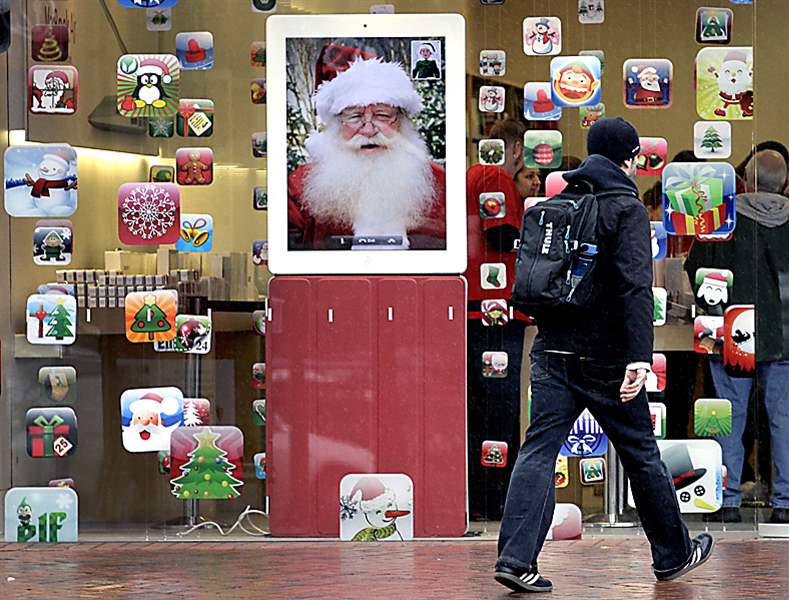
Pays to know top trends for this holiday season
Retail foundation makes optimistic spending forecast
11/4/2012
Stores are starting their holiday seasons earlier because shoppers are starting their gift-buying earlier too. A survey shows that at least 22 percent say they are beginning to buy gifts in October.
ASSOCIATED PRESS

Stores are starting their holiday seasons earlier because shoppers are starting their gift-buying earlier too. A survey shows that at least 22 percent say they are beginning to buy gifts in October.
Holiday shopping is already upon us, with retailers gearing up for the crucial sprint from Halloween to Christmas, and Americans are expected to spend more on gifts than last year as the economy slowly recovers.
The National Retail Federation has forecast the country’s holiday spending will rise 4.1 percent, to about $586 billion. That’s a slower growth rate than in 2011, when holiday sales increased at a 5.6 percent clip. Mixed economic indicators and uncertainties about the election are weighing on consumers’ minds, the NRF said.
Still, $586 billion is a lot to spend on gifts — an average of about $750 per holiday shopper, the NRF said.
“This is the most optimistic forecast NRF has released since the recession. In spite of the uncertainties that exist in our economy and among consumers, we believe we’ll see solid holiday sales growth this year,” said NRF chief executive Matthew Shay, in a statement.
Here are five holiday shopping trends this year:
1. Shopping is starting earlier than ever. It seems that holiday creep knows no bounds. It’s tough to say who’s behind the seemingly ever-earlier surge in shopping: While many consumers bemoan the ever-earlier decorations, surveys also show that more people than ever are shopping early this year, and retailers follow the money.
And early shopping is also spreading online. The NRF recently released a survey showing that almost 62 percent of retailers planned to start offering online holiday specials by Halloween, up from 53 percent last year.
Twenty-two percent of consumers said they plan to start their holiday shopping in October this year, up from 20 percent last year.
2. Black Friday might be further diluted. The day after Thanksgiving is synonymous with two things: groans about overeating and a day of intense bargain-hunting at the mall. But for the past few years, the day after Thanksgiving hasn’t been the only day to indulge in shopping. Black Friday is giving way to shopping on Thanksgiving day itself, both in-store and online.
Gap, Kmart, Target, and Toys R Us all opened on Thanksgiving last year, and many other malls and retailers moved the start of their Black Friday sales from early Friday morning to midnight. With the pressure on to increase sales every year, retailers who don’t open earlier face the prospect of being left behind.
Online spending is also increasing during the holiday itself. About 22 percent of consumers shopped online on Thanksgiving last year, up from 15 percent in 2008. ComScore reported online sales grew 18 percent on Thanksgiving last year, to $479 million.
But don’t count Black Friday out. According to ShopperTrak, Black Friday remained the busiest shopping day of the year in 2011, followed by the Saturday before Christmas.
3. Layaway is back, and bigger than last year. A few years ago, layaway was effectively gone, replaced by credit cards as an effective way for people to purchase on credit. But with the recession and the credit crunch, layaway has made a comeback, with major retailers bringing it back.
Here’s how layaway works: You pay a small fee, often $5, and the retailer puts your goods aside for you. You make payments every week for a set schedule, and get the item you purchased when you’ve paid if off. If you don’t complete your payments, you get a refund for everything but the fee.
Layaway shows no signs of stopping this year. Major retailers such as Toys R Us and Wal-Mart started their seasonal layaway programs earlier than ever. Toys R Us is offering free layaway through Dec. 16, an extension of its original Oct. 31 deadline.
4. Gift cards still top people’s wish lists. Gift cards are the single most popular item on people’s wish lists, according to a survey by the NRF. Of those surveyed, 60 percent said they want gift cards, followed by apparel at 49 percent and books, CDs, DVDs, and video games at 46 percent.
And with relatively new restrictions on how long the cards have to last before they expire (five years) and how much retailers can take in hidden fees, they’re a safer option for consumers.
There’s also a growing number of Web sites, such as PlasticJungle.com and GiftCards.com, that allow people to sell gift cards they don’t want. That can save you from forcing yourself to make a trip to a store you would never usually shop at, and give you the freedom of cash.
5. Online, mobile growth boom continues. Sales on the Internet and mobile devices are still the fastest-growing segment of holiday purchases. The NRF estimates this year that online sales will grow 12 percent during the holidays, to $96 billion.
More than half of consumers surveyed, 52 percent, planned to shop for some gifts online this year. That’s the highest percentage since the NRF started its surveys, and up from 47 percent last year.
One benefit of this is that free shipping is becoming more widespread. The NRF found that nine out of 10 retailers surveyed will offer some form of free shipping this year for online orders, either with conditions such as a minimum purchase or in a specific time frame.